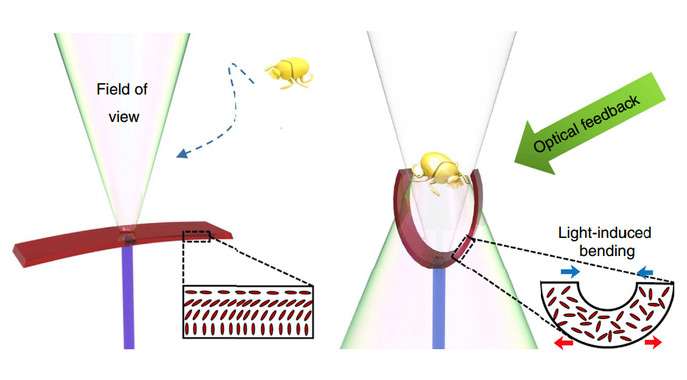May 24, 2017 report
An artificial Venus flytrap that operates on light

(Tech Xplore)—A trio of researchers with Tampere University of Technology in Finland has designed and built a simple robot that mimics the actions of a Venus flytrap plant. In their paper published in the journal Nature Communications, Owies Wani, Hao Zeng and Arri Priimagi describe the concept behind their robot, how it works and some possible uses for it.
Venus flytrap plants capture insects via sensitive hair-like structures, which when touched, trigger a reaction that leads to their jaw-like leaves quickly closing and trapping prey. In this new effort, the researchers sought to mimic this activity in a new way—by building a very simple robot that consists of nothing but a fiber cable and light-activated leaves.
The robot is small, too—its leaf is just a centimeter long, and is thinner than a human hair. The leaf constricts via tiny molecular switches when exposed to light. The researchers attached the leaf to the fiber cable like a T-connector with a hole at the junction point for the light to pass through. Light was fed into the fiber cable and flared out as it passed into the air just in front of the robot. If an object was moved into that light space, some of the light was bounced back to the leaf—if enough of the light was bounced back, the leaf reacted by bending. With both sides of the leaf bending in the same direction, they formed a claw of sorts, which could grab an object such as a tiny piece of Styrofoam. The object was released by simply turning off the light source.
The researchers report that their robot is capable of clasping and holding objects that weigh as much as 100 times more than it does and that it is able to do so autonomously. It also is able to close its leaves in approximately 200 milliseconds, approximately half as fast as a real flytrap. They point out that no programming was needed, nor any secondary power supply. The only input was laser light, which they also note could just as easily have come from an LED.
More information: Owies M. Wani et al. A light-driven artificial flytrap, Nature Communications (2017). DOI: 10.1038/ncomms15546
Abstract
The sophistication, complexity and intelligence of biological systems is a continuous source of inspiration for mankind. Mimicking the natural intelligence to devise tiny systems that are capable of self-regulated, autonomous action to, for example, distinguish different targets, remains among the grand challenges in biomimetic micro-robotics. Herein, we demonstrate an autonomous soft device, a light-driven flytrap, that uses optical feedback to trigger photomechanical actuation. The design is based on light-responsive liquid-crystal elastomer, fabricated onto the tip of an optical fibre, which acts as a power source and serves as a contactless probe that senses the environment. Mimicking natural flytraps, this artificial flytrap is capable of autonomous closure and object recognition. It enables self-regulated actuation within the fibre-sized architecture, thus opening up avenues towards soft, autonomous small-scale devices.
© 2017 Tech Xplore




















